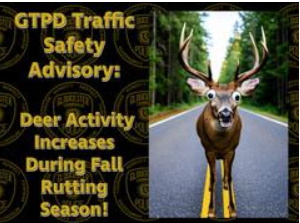
From our friends at New Jersey Fish & Wildlife : Motorists are reminded to be extra vigilant on roadways as the fall white-tailed deer rut, or mating season, gets underway. Increased deer activity related to the rutting season comes as the amount of daylight decreases, increasing collision risks, especially during morning and evening commutes.
Deer are more likely to suddenly enter roadways as bucks pursue does, increasing the risk that drivers may need to stop suddenly. Deer activity is more likely to occur during the early morning and around sunset, when visibility is more difficult due to darkness or sun glare.
Read more: GTPD Traffic Safety AdvisoryPeak mating season for deer in New Jersey runs from late October to mid-December. Awareness of the presence of deer near or on roadways will become even more important when daylight saving time ends at 2 a.m. on Sunday, November 2. This means that many commutes will align with the time when deer are most active, and lighting conditions may be the most difficult for driving.
Drivers can stay safe by following these tips:
Slow your vehicle if you see a deer and then watch for sudden movement. If the deer is on the road and doesn’t move, wait for the deer to cross and the road is clear. Do not try to drive around the deer.
Watch for “Deer Crossing” signs. Drive slower when traveling through areas known to have a high concentration of deer so there is enough time to stop, if necessary.
Use high beams during dark periods if there is no oncoming traffic or vehicle ahead. High beams will be reflected by the eyes of deer on or near roads.
If you see one deer, assume that others may be in the area.
Don’t tailgate. The driver ahead might have to stop suddenly to avoid colliding with a deer.
Always wear a seatbelt, as required by law. Drive safely and sensibly, following the speed limit, factoring for weather, available lighting, traffic, curves and other road conditions.
Do not swerve to avoid impact if a collision appears inevitable because a deer may counter-maneuver suddenly. Apply brakes appropriately and stay in your lane. Collisions are more likely to become fatal when a driver swerves to avoid a deer and instead collides with oncoming traffic or a fixed structure along the road.
Obey the state’s hands-free device law or refrain from using cellular devices while driving.
Report any deer-vehicle collision to a local law enforcement agency immediately.